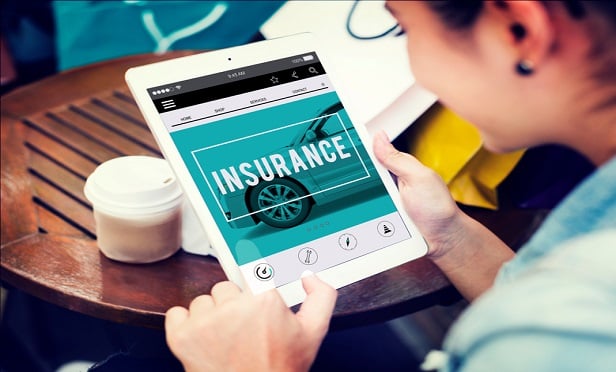 The digital channel has become the preferred policyholder means of interacting with auto insurers, exceeding one-on-one communication with agents, according to the J.D. Power 2020 U.S. Auto Insurance Study™. (iStock)
The digital channel has become the preferred policyholder means of interacting with auto insurers, exceeding one-on-one communication with agents, according to the J.D. Power 2020 U.S. Auto Insurance Study™. (iStock)Results from the the J.D. Power 2020 U.S. Auto Insurance Study™ released Thursday indicate insurance carriers are now moving beyond digital transformation and settling into digital business models.
For the first time in more than two decades of studying auto insurance customer satisfaction, J.D. Power analysts have concluded that customer engagement and retention in 2020 hinges more carrier websites than insurance-agent interactions.
“Digital servicing is here and now the most important servicing channel for customers,” Robert Lajdziak, senior consultant for insurance intelligence at J.D. Power, told PropertyCasualty360 in response to results of the study, which was released June 11th.
“We’ve seen this trend developing for several years, but this is the first time that the digital channel has become the preferred means of interacting with auto insurers, exceeding one-on-one communication with agents,” Lajdziak said in a press release about the study. “This has huge implications for the industry because it puts the focus squarely on digital investment to notably expand creating seamless customer touch points. It’s an area in which the major national carriers excel, versus hyper-local, albeit knowledgeable, agent networks.”
He added in comments to PC360 that dated digital interfaces now have the power to drive away insurance customers.
“High quality websites (and digital properties in general) make customers’ lives easier and can often solve for a customer pain-point before there is mass adoption,” he said. “That pain-point can be something as simple as eliminating the need for a customer to call someone, a chore that has widely fallen out of favor, but also be something unique that takes full advantage of its digital environment.”
What are the hallmarks of less successful insurer websites?
“Failed attempts are websites often occur when an analog process is adopted and put on the screen for the user,” Lajdziak said. “For example, a form, application, or documentation that is filled out online. The analog form on the screen doesn’t take advantage of its digital environment where smart text, auto fill, e-signature, even the ability to chat with a representative could all easily make it a quicker, simpler process for customers.”
The J.D. Power’s U.S. Auto Insurance Study™ is in its 21st year. The study is based on responses from 40,123 auto insurance customers and was fielded in February and March 2020. It examines customer satisfaction in five factors:
- Billing process and policy information;
- Claims;
- Interaction;
- Policy offerings; and
- Price.
Here are some other key takeaways from the J.D. Power 2020 U.S. Auto Insurance Study™:
- Digital investments pay dividends: Customer experience with auto insurer websites contributes more to satisfaction than agents, accounting for 34% of an insurer’s total interaction score. That’s one percentage point higher than in the agent channel, which accounts for 33% of total interaction satisfaction. This trend toward increased reliance on the digital channel and decreased reliance on the agent channel has been building steadily for more than a decade.
- Record high satisfaction driven in part by digital: Overall customer satisfaction with auto insurers improves in 2020 to a record high of 835 (on a 1,000-point scale). National carriers such as GEICO, State Farm and Allstate have earned some of the most significant gains, together ranking highest in six of the 11 regions in the study, aided by the growth of their digital channels.
- Trust is critical, but insurers have work to do: There is a strong correlation between scores for trust and those for overall satisfaction. On average, a one-point increase in trust (on a 5-point scale) would correlate with a 118-point increase in overall satisfaction. Despite the importance of trust, only 42% of all auto insurance customers say they “strongly agree” that they trust their insurer. By fulfilling service expectations and putting customers’ interests first, among other customer-centric initiatives, insurers can succeed in this critical-to-retention metric.
- Loyalty heavily influenced by claim history: Customers are least likely to renew their policies when part of an insurance claim is denied. Conversely, when customers have experienced a claim that was fully approved and settled, satisfaction is significantly higher and generates the greatest likelihood of renewal. What’s more, those customers who experienced sub-optimal claim outcomes and remained with their carrier were more diligent about understanding their policy and what it covers going forward.
It is important to note that insurance agents still do have a role to play in the digital business landscape.
“There are some activities and needs of customers that the agent/CSR is still the preferred touch-point. When it comes to price and policy coverage, often times younger, digitally savvy customers, would still prefer to pick up the phone to perhaps validate their research online,” Lajdziak said. “That said, agents do need to further clarify their value proposition to customers post-sale of the policy. Many customers never speak to or talk to their agent post-sale. That represents a gap in value.”
The bottom line for insurance agents: “Focus on helping customers understand their product so they feel like they are getting good value for premiums paid, build an agent-client relationship where the agent become a trusted advisor rather than a transaction channel because the notion of trust is really critical. If the customer trusts their agent is taking care of the relationship for them, they don’t need to take the steps to do it themselves.”
Related:
"loyalty" - Google News
June 12, 2020 at 05:00PM
https://ift.tt/2XWnQlv
Auto insurance customer loyalty in 2020 hinges on digital UX - PropertyCasualty360
"loyalty" - Google News
https://ift.tt/2VYbPLn
https://ift.tt/3bZVhYX
Bagikan Berita Ini














0 Response to "Auto insurance customer loyalty in 2020 hinges on digital UX - PropertyCasualty360"
Post a Comment